
Contains cover sheet with teacher examples.
- Subject:
- Elementary Education
- Material Type:
- Lesson Plan
- Author:
- Johanna Richards
- Date Added:
- 05/30/2019

Contains cover sheet with teacher examples.

After teaching a unit about rocks and minerals, students are challenged with picking a site for a tunnel, drilling through a mountain with clay, reinforcing the hole to create a tunnel, and then testing their design. Students will also estimate and calculate the amount of time it takes them to drill.
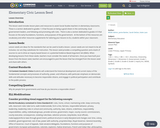
IntroductionThis lesson seed includes lesson plans and resources to assist Social Studies teachers in elementary classrooms. These is a section dedicated to grades 1-3 that focuses on being a good citizen in the community, local governement leaders, and following and promoting safe rules. There is also a section dedicated to grades 4-5 that focuses on the early foundations, functions, and purposes of the governement. At the bottom of the resources is an academic vocabulary word list for key concepts to consider providing visual support to assist you in tailoring your lessons to ELL students within your classroom, along with link to WIDA CAN DO Descriptors.Lesson Seeds:Lesson seeds are ideas for the standards that can be used to build a lesson. Lesson seeds are not meant to be all-inclusive, nor are they substitutes for instruction. This lesson seed provides a compelling question and a bank of sources to use to drive an inquiry based lesson or a potential Evidence Based Argument Set (EBAS). When developing lessons from these seeds, teachers must consider the needs of all learners. Once you have built your lesson from the lesson seed, teachers are encouraged to post the lesson that has emerged from this lesson seed and share with others.
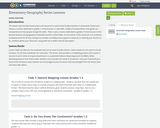
IntroductionThis lesson seed includes lesson plans and resources to assist Social Studies teachers in elementary classrooms. These is a section dedicated to grades 1-3 that focuses on map skills, modes of transportation, how goods are transported and how people change the earth. There is also a section dedicated to grades 4-5 that focuses on the physical features and grography of Maryland and the United States. At the bottom of the resources is an academic vocabulary word list for key concepts to consider providing visual support to assist you in tailoring your lessons to ELL students within your classroom, along with link to WIDA CAN DO Descriptors.Lesson Seeds:Lesson seeds are ideas for the standards that can be used to build a lesson. Lesson seeds are not meant to be all-inclusive, nor are they substitutes for instruction. This lesson seed provides a compelling question and a bank of sources to use to drive an inquiry based lesson or a potential Evidence Based Argument Set (EBAS). When developing lessons from these seeds, teachers must consider the needs of all learners. Once you have built your lesson from the lesson seed, teachers are encouraged to post the lesson that has emerged from this lesson seed and share with others.

Overview:This unit is presented as a series of cooperation, team buidling, and problem solving learning tasks. Learning tasks should begin as partner to partner, and progress to small group, large group, and finally, whole class. Standards 4 and Standards 5 are addessed in this unit. Teachers are encouraged to select the learning tasks that best fit their teaching style and students’ needs. Learning Tasks can be implemented across grade levels using different extensions and refinements. Modifications and accomodations specific to your learners are strongly recommended.

Overview:This unit is presented as a series of cooperation, team buidling, and problem solving learning tasks. Learning tasks should begin as partner to partner, and progress to small group, large group, and finally, whole class. Standards 4 and Standards 5 are addessed in this unit. Teachers are encouraged to select the learning tasks that best fit their teaching style and students’ needs. Learning Tasks can be implemented across grade levels using different extensions and refinements. Modifications and accomodations specific to your learners are strongly recommended. The National Standards and Grade Level Outcomes in this unit are referenced from the "National Standards & Grade Level outcomes for K-12 Physical Education," book. SHAPE America Standards: Standard 4. The physically literate individual exhibits responsible personal and social behavior that respects self and others.Standard 5. The physically literate individual recognizes the value of physical activity for health, enjoyment, challenge, self-expression and/or social interaction.SHAPE Grade-Level Outcomes:KindergartenFollows directions in group settings (e.g., safe behaviors, following rules, taking turns). (S4.E1.K)Acknowledges responsibility for behavior when prompted. (S4.E2.K)Follows instruction and directions when prompted. (S4.E3.K)Shares equipment and space with others. (S4.E4.K)Follows teacher directions for safe participation and proper use of equipment with minimal reminders. (S4.E6.K)Acknowledges that some physical activities are challenging/difficult. (S2.E2.K)First GradeAccepts personal responsibility by using equipment and space appropriately. (S4.E1.1)Follows the rules and parameters of the learning environment. (S4.E2.1)Responds appropriately to general feedback from the teacher. (S4.E3.1)Works independently with others in a variety of class environments (e.g., small and large groups). (S4.E4.1)Exhibits the established protocols for class activities. (S4.E5.1)Follows teacher directions for safe participation and proper use of equipment without teacher reminders. (S4.E6.1)Recognizes that challenge in physical activity can lead to success (S5. E2.1)Describes positive feelings that result from participating in physical activities (S5. E3. 1a)Second GradeWorks independently with others in partner environments. (S4.E4.2)Recognizes the role of rules and etiquette in teacher-designed physical activities. (S4.E5.2)Works independently and safely in physical education. (S4.E6.2a)Works safely with physical education equipment. (S4.E6.2b)Compares physical activities that bring confidence and challenge. (S5.E2.1)Third GradeExhibits personal responsibility in teacher-directed activities. (S4.E1.3)Works independently for extended periods of time. (S4.E2.3)Accepts and implements specific corrective feedback from the teacher. (S4.E3.3)Works cooperatively with others. (S4.E4.3a)Praises others for their success in movement performance. (S4.E4.3b)Recognizes the role of rules and etiquette in physical activity with peers. (S4.E5.3)Works independently and safely in physical activity settings. (S4.E6.3)Reflects on the reasons for enjoying selected physical activities (S5. E3. 3)Describes the positive social interactions that come when engaged with others in physical activity. (S5.E4.3)Fourth GradeExhibits responsible behavior in independent group situations. (S4.E1.4)Reflects on personal social behavior in physical activity. (S4.E2.4)Listens respectfully to corrective feedback from others (e.g., peers, adults). (S4.E3.4)Praises the movement performance of others both more skilled and less skilled. (S4.E4.4a)Exhibits etiquette and adherence to rules in a variety of physical activities. (S4.E5.4)Works safely with peers and equipment in physical activity settings. (S4.E6.4)Rates the enjoyment of participating in challenging and mastered physical activities (S5. E2. 4)Describes and compares the positive social interactions when engaged in partner, small-group and large-group physical activities. (S5.E4.4)Fifth GradeEngages in physical activity with responsible interpersonal behavior (e.g., peer to peer, student to teacher, student to referee). (S4.E1.5)Participates with responsible personal behavior in a variety of physical activity contexts, environments and facilities. (S4.E2.5a)Exhibits respect for self with appropriate behavior while engaging in physical activity. (S4.E2.5b)Gives corrective feedback respectfully to peers. (S4.E3.5)Accepts,recognizes and actively involves others with both higher and lower skill abilities into physical activities and group projects. (S4.E4.5)Applies safety principles with age appropriate physical activities. (S4.E6.5)SHAPE America - Society of Health and Physical Educators. National Standards & Grade-Level Outcomes for K-12 Physical Education. Human Kinetics Publishers, 2014, www.shapeamerica.org/standards/pe/upload/Grade-Level-Outcomes-for-K-12-Physical-Education.pdf.Image source: "Colorful Cooperation" by OpenClipart-Vectors / 27439 images from Pixabay.com at https://pixabay.com/en/circle-colorful-cooperation-1300241/

Overview:This unit is presented as a series of cooperation, team buidling, and problem solving learning tasks. Learning tasks should begin as partner to partner, and progress to small group, large group, and finally, whole class. Standards 4 and Standards 5 are addessed in this unit. Teachers are encouraged to select the learning tasks that best fit their teaching style and students’ needs. Learning Tasks can be implemented across grade levels using different extensions and refinements. Modifications and accomodations specific to your learners are strongly recommended. The National Standards and Grade Level Outcomes in this unit are referenced from the "National Standards & Grade Level outcomes for K-12 Physical Education," book.
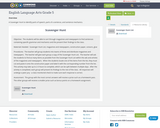
A Scavenger Hunt to identify parts of speech, parts of a sentence, and sentence mechanics.
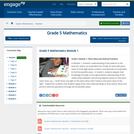
In Module 1, students’ understanding of the patterns in the base ten system are extended from Grade 4’s work with place value of multi-digit whole numbers and decimals to hundredths to the thousandths place. In Grade 5, students deepen their knowledge through a more generalized understanding of the relationships between and among adjacent places on the place value chart, e.g., 1 tenth times any digit on the place value chart moves it one place value to the right. Toward the module’s end students apply these new understandings as they reason about and perform decimal operations through the hundredths place.
Find the rest of the EngageNY Mathematics resources at https://archive.org/details/engageny-mathematics.

Science Proficiency Scales - Grade 5

The attached lesson is designed for Grade 5 English Language Arts students. Students will analyze and evaluate the elements of informational text, identify and apply knowledge of organizational patterns to comprehend informational texts. This lesson addresses the following NDE Standard: NE LA 5.1.6.jIt is expected that this lesson will take students 120 minutes to complete.
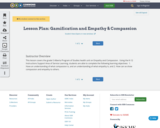
This lesson covers the grade 5 Alberta Program of Studies health unit on Empathy and Compassion. Using the K-12 Instructions Support Area of Service Learning, students are able to complete the following learning objectives: 1. Have an understanding of what compassion is, and an understanding of what empathy is, and 2. How can se show compassion and empathy to others.

Air Pollution - Earth & Space Science Grade 5

Bulding a Biosphere - Life Science Grade 5

Forest Conservation - Grade 5

Ice Cream Celebration - Grade 5

Movement of Matter- Life Science Grade 5

Patty the Pattern Maker - Grade 5

Represent It - Grade 5

Roller Coasters - Grade 5